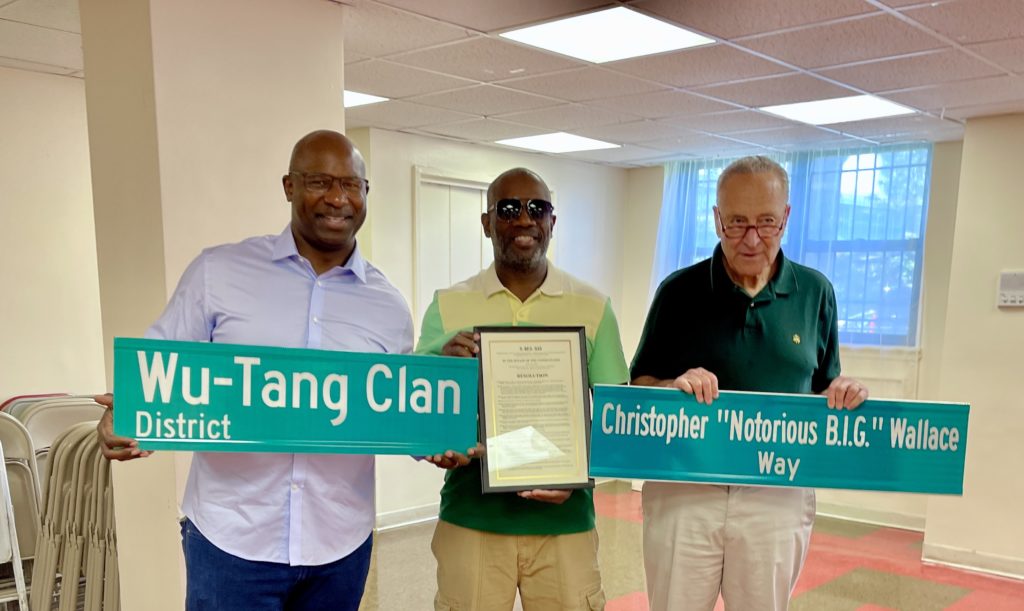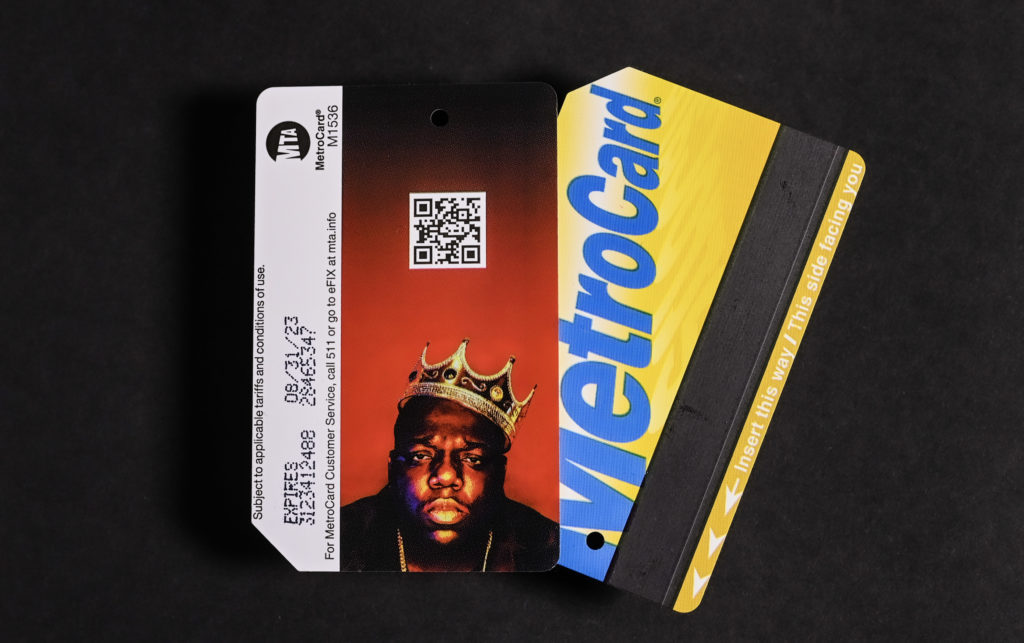Biggie Smalls always repped Brooklyn to the fullest. And now his city is doing the same for him.
This past Saturday would have been the 50th birthday for the rapper, whose real name was Christopher Wallace, a Clinton Hill (then called Bed-Stuy) native who rose to prominence with searing lyrics and flows of his rags-to-riches story. He was gunned down in Los Angeles in 1997 and no one has been charged for the murder.
Starting at midnight on Saturday, fans waited for hours at subway stations to try and get a limited edition Biggie Smalls MetroCard. The Empire State Building was lit red and white in honor of the rapper. And Lincoln Center will be holding a tribute in June.
For many in New York, and especially Brooklyn, Biggie is as iconic as a Yankees fitted or a dollar slice of pizza. He’s long been a true staple of the city and a shining symbol for Brooklyn grit. But for many years, this level of institutional recognition was all but a dream.

LeRoy McCarthy with Congressman Jamaal Bowman and Senator Chuck Schumer inside the recreation room at 1520 Sedgwick Avenue in the Bronx. Better known as the “birthplace of Hip-Hop,” this was where DJ Kool Herc performed to a crowd on August 11, 1973 (Credit: LeRoy McCarthy)
LeRoy McCarthy started a petition in 2013 to get the street corner on St. James Place between Fulton Street and Gates Avenue named Christopher Wallace Way.
“When I started this effort independently, I was saying that there was not recognition for hip hop as there is for rock and roll, or jazz or country. Hip hop is an indigenous and American creation – a composite of different music and art forms to create what we now know as hip hop,” McCarthy said in an interview.
That year, members of Brooklyn’s Community Board 2 reportedly rejected a proposal to rename a street corner after him due to his drug-dealing history, misogynist language used in his lyrics, and for being too overweight.
“And as a matter of fact, his mom [Wallace’s Mother] asked me not to do it, because the sentiment was so bad. And it was so distasteful the way that they spoke of her son, in these publications and in the community,” former Councilman Robert Cornegy said in an interview. Cornegy grew up in the same Brooklyn building as the late rapper, promising Wallace’s mother that he would someday honor her son’s legacy.
While explaining the contributions Biggie made to the community, Cornegy recalled a community board member interrupting his speech to read Biggie’s lyrics, in an attempt to sway people against voting for a street renaming.
“She [Wallace’s mother] didn’t want to do it, quite frankly. We backed off the first time, because she couldn’t take hearing the way that people felt about her son, which didn’t represent what 99 percent of the community and the culture understood the significance, but that 1 percent was very loud, who were vehemently against the street and the park naming,” Cornegy said.
Crispus Attucks Park was dedicated to Biggie in 2017, and in 2019 the street corner that he grew up on was renamed Christopher Wallace Way.
“It puts a little bit of a smirk on my face when I know how people initially felt and have we not stayed diligent with making sure that the world was aware of his contributions. I don’t know what would have happened. So there’s a whole bunch of people, not just myself on the ground, who really, really hammered this home consistently about the contributions,” Cornegy said.
Cornegy also emphasized the work that has been done by the Christopher Wallace Memorial Foundation. While B.I.G used to stand for “Business instead of Game”, the foundation, which helps provide learning materials and fixies libraries, has transformed the definition to be “Books Instead of Guns”.
As an avid Biggie fan, McCarthy waited over an hour and a half to try and get one of the coveted 50,000 limited edition metro cards on Saturday morning. He wasn’t able to snag one. But as luck would have it, McCarthy met Barron Claiborne, the photographer who took the iconic photo of Biggie used on the MetroCard, at the block party he co-organized in Brooklyn.
McCarthy swapped one of his Christopher Wallace Way signs for a MetroCard autographed by Claiborne.
McCarthy says that he has been speaking with Speaker Adrienne Adams to get the NYC council to recognize August as Hip Hop recognition month as well as members of the Los Angeles City Council to pass a similar resolution. He was part of efforts that got the month recognized by the federal government, celebrating the genesis of hip hop by DJ Kool Herc on August 11, 1973 in the Bronx.
“But what I’m trying to do is have the intersection of St. James and folk history to be somewhat of an Abbey Road of hip hop – like a Graceland type thing or 56 Hope Road where Bob Marley’s house is. So it’s like an attraction, a part of Americana. Honoring hip hop is one thing, but this would also be a landmark for hip hop.”



